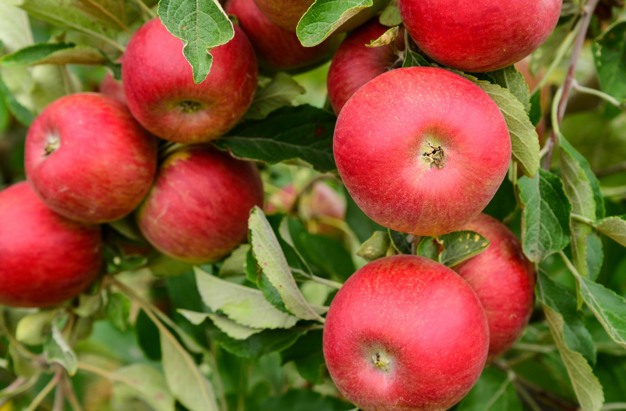The annual apple and pear crop estimate from New Zealand Apples and Pears, which was issued in February 2024, forecasted the national crop to be up 12 per cent on the 2022 crop total, a rebound from the 2023 crop total that suffered significant damage from Cyclone Gabrielle.
Export volume was estimated at 21.2 million boxes, known in the industry as tray carton equivalents or 382,000 metric tonnes. The fruit is expected to have excellent size, colour, eating and flavour properties, and higher dry matter, which enables better storage of the fruit.
 Karen Morrish, CEO of New Zealand Apples and Pears says the favourable forecast, after an incredibly tough few years with economic losses due to COVID-19 and Cyclone Gabrielle, is down to near-perfect growing conditions and hard work.
Karen Morrish, CEO of New Zealand Apples and Pears says the favourable forecast, after an incredibly tough few years with economic losses due to COVID-19 and Cyclone Gabrielle, is down to near-perfect growing conditions and hard work.
"Hawke's Bay lost 610 hectares of apple trees out of a total of 6500 hectares, in last year's cyclone but that figure may be a bit short as it is based on blocks totally destroyed, as it doesn't take into account blocks that were partially destroyed," explains Karen.
"It is still too early to gauge exactly how much of the 610 hectares will be replanted in pipfruit – which will happen in the winter months of 2024. However, a positive 2024 harvest season will certainly help with confidence to reinvest."
Good conditions and hard work
The weather conditions in all growing regions have been excellent, with the warm and dry conditions pipfruit needs. From Gisborne down to Central Otago, spring and summer conditions have set the trees up with a typical crop load of high-quality fruit with exceptional eating quality. The fruit is expected to have excellent size, colour, eating and flavour properties, and higher dry matter, which enables better storage of the fruit.
"While conditions have been great, the season's expected success is also down to sheer hard work. Growers work hard every season, but for those impacted by Cyclone Gabrielle, the past year has been tough and continues to be tough for those still recovering. Many growers had to dig their orchards out of silt, so it is amazing and surprising to see where we are today after where we were a year ago. Apple trees have proved to be resilient and so too are our growers.
"We are certainly in a better place than what I would have imagined a year ago, and aside from the impacts of the cyclone there are often challenges in our industry that affect our buoyancy, for example, the cost of production is high, but we continue to work hard and produce the best apples and pears in the world."

Volumes and exports
Pears are harvested from February through to July and make up 296 hectares of pear production across 126 orchards. Pears currently account for only 6% of New Zealand's pipfruit crop, and 0.3% of the total Southern Hemisphere pear export volume. In 2022, the total export volume for the pear category was 2,400 metric tonnes.
Apples are harvested from February through June made up of 68 growers managing 988 orchards, across 10,760 hectares, and produced 340,725 tonnes in 2022. Apples only account for 0.5% of the total world apple production and 4% of the total global export apple market. In 2022 New Zealand exported 340,403 MT of apples.
"Our fruit is widely regarded as the best in the world, its therefore acknowledged as a premium product and is in high demand by international markets. Our fruit is healthy and sustainable - good for people and the planet.
New Zealand apples and pears are exported to 65 countries around the world, the major international markets are Asia, Europe, North America and the Middle East.
For pears China and Taiwan were the largest export markets in 2022 and took approximately 70% of the pear crop, followed by the USA, Singapore, and Fiji.
For apples, the largest export markets in 2022 were China (16%), Vietnam (13%), Germany (10.6%) Taiwan (9.3%).
New varieties
"A good example of our progression to new varieties is our recent innovations at Prevar, our breeding programme co-owned with Plant and Food and Australian Apples and Pears, where we have seen unique cultivars produced such as the PiqaBoo® pear which is bred specifically for the Asian consumer, catering to their red and sweet pip fruit preferences. We have a vision to rejuvenate our pear industry, modelled on the apple industry which has seen great success in its transition from Europe to Asia over the last decade."
There is an increase in both apple and pear trees being planted across New Zealand, both in traditional and emerging growing regions. There is commercial pear planting in Central Otago and new apple planting in Canterbury. Much of the new planting is shifting to a high-production model to improve yields and quality from the same hectarage
"An increase in pipfruit planting will also be reflective of the development of new market access. We are pleased to see growth and keen to support it. Before the cyclone hit, we were a $900 million industry, with a projection now of reaching the $2 billion mark in a decade."
For more information:
 Hanna Butler
Hanna Butler
New Zealand Apple and Pears
Tel: +64 22 4799 043
hanna@applesandpears.nz
www.applesandpears.nz
